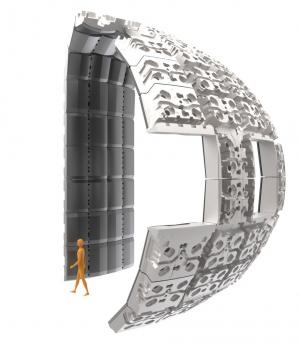In the ITER machine, hydrogen isotopes deuterium and tritium will fuse to create a helium nucleus and a neutron, releasing a lot of energy in the process. Deuterium is readily available from seawater, but tritium is rare. ITER will procure the tritium fuel necessary for its operational lifetime from the limited global inventory, but for DEMO and the machines that follow, the successful development of tritium breeding within the blanket is essential. This is achieved by introducing lithium in the blanket, which will react with the neutrons from the fusion reaction to produce tritium. (A neutron multiplier such as beryllium is also used in the blanket to increase the number of neutrons available for such a reaction.) ITER will offer a unique opportunity to test mockups of tritium-breeding blankets (called test blanket modules) in a real fusion environment, and provide valuable information on local tritium breeding. Not only will this information boost the confidence that tritium self-sufficiency can be achieved in later-stage devices, but it will also provide a basis from which one can extrapolate to design DEMO or power plant blankets.
A second major difference is that the ITER blanket won't be relied on to efficiently remove deposited power for electricity generation. Instead, the power produced will be captured by cooling water at low temperature (70 °C at inlet)—and not be used for electrical power production. In DEMO and beyond, the power carried by the coolant will be transferred to a power cycle fluid (water/steam for a Rankine cycle, or helium for a Brayton cycle) through a heat exchanger, and a high-temperature coolant will be required for economically acceptable power cycle efficiency. For this reason, ITER's test blanket modules will be tested with their own independent cooling systems using either helium-coolant at 500 °C or water-coolant at pressurized water reactor conditions.
ITER will also operate with a choice of blanket materials that is not fully applicable to DEMO, where the neutron fluence (a measure of the total number of fusion neutrons per unit area over the component lifetime) is expected to be about 30 times higher. For instance, higher fluences would swell the austenitic steel 316 chosen for ITER, affecting its structural integrity. A different structural material will be required to operate at these higher temperatures and neutron fluences. At the same time, the aim is to minimize the associated radioactive waste of the structure at its end of life by successfully developing and utilizing low-activation structural materials with much shorter decay half-lives (about 100 years or less). Prime candidates are the newly developed reduced-activation ferritic/martensitc (RAFM) steels that are planned for use in the test blanket module structures.
What will we learn from the ITER blanket that has relevance for DEMO and beyond?
I would look at this question from a broader perspective.
The overall programmatic objective of ITER is to demonstrate the scientific and technological feasibility of fusion energy. While the physics side of this objective tends to be well appreciated, less emphasis is put on the equally important goal of demonstrating the availability, integration and testing of technologies essential for a fusion reactor. In addition to the key physics information, we expect a wide range of DEMO-relevant technology information out of ITER.
This is clear for the vacuum vessel and most ex-vessel components and systems, such as the superconducting coils, the cryogenic system, the tritium system, diagnostics systems and the cooling system. For the in-vessel components, in addition to key tritium breeding blanket information to be obtained from the ITER test blanket module program, the following important information will be obtained in a range of technology areas in particular for the blanket and divertor.
- Blanket and divertor design, manufacturability and operation;
- First wall and divertor heat fluxes, including first wall shaping and alignment (to the millimetre level) to maintain acceptable heat flux levels and to protect leading edges and penetrations;
- Plasma-facing component and material behaviour under normal and off-normal conditions including erosion;
- Neutron shielding performance;
- Tolerance management for an assembly of components;
- Assembly and remote handling;
- Integration of all these components and systems while accommodating interface requirements;
- Reliability and availability of these fusion systems and components.





